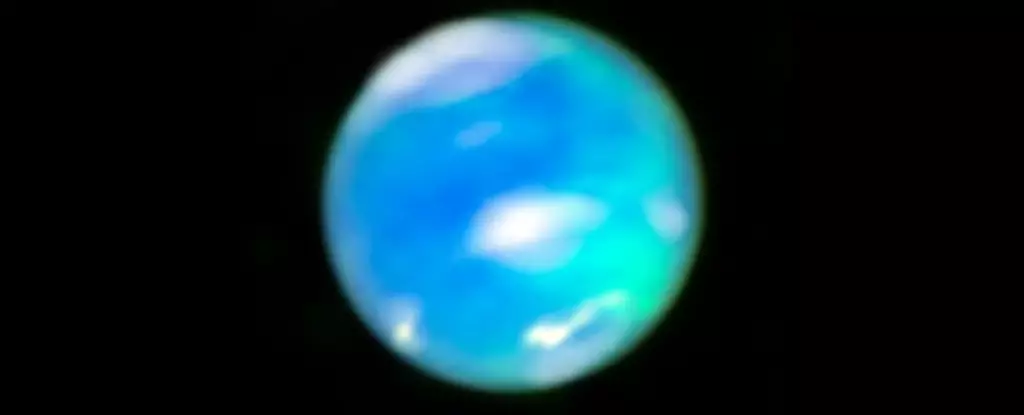In a captivating celestial revelation, the most elusive aurora within our Solar System has recently come to light. Neptune, the ethereal blue planet positioned at the far reaches of our cosmic neighborhood, has been captured shimmering brilliantly in the near-infrared spectrum. This groundbreaking discovery was made possible through the advanced capabilities of the James Webb Space Telescope (JWST), which has unveiled an astonishing natural phenomenon that exists far beyond the familiar realms of Earth and its solar siblings. Astronomers have long understood that auroras are not unique to our planet, but the striking visual representation on Neptune has garnered significant interest and expanded our understanding of planetary atmospheres.
A New Chapter in Astronomy
For decades, the cosmic dance of auroras has fascinated scientists—not only for their beauty but also for the insights they provide into the interactions between celestial bodies and solar winds. With this recent observation, Neptune joins the illustrious ranks of planets ranging from the vibrant displays seen on Earth to Jupiter’s formidable and continuous auroral activity. Each planetary aurora is a unique expression of how solar particles engage with planetary environments, and now, Neptune’s has finally illuminated the narrative.
Earth’s auroras, characterized by an array of vivid colors, emerge from the collision of solar wind particles with the planet’s robust magnetic field. However, the nature of these phenomena can vary drastically. From Jupiter’s intensely vibrant ultraviolet lights to Saturn’s similar displays, and the green hues adorning Venus, each planetary body showcases a distinct auroral signature. Even Mercury exhibits an aurora of a different form altogether, reflecting interactions at its mineral-laden yet atmosphere-less surface.
Unlocking the Mystery of Neptune
Historically, the stark distance of planets like Uranus and Neptune from the Sun posed a question regarding their potential for auroras. Uranus, at nearly 19 times the distance of Earth from the Sun, and Neptune, a staggering 30 times further, were largely considered inhospitable for such phenomena. Yet in 2023, a closer examination of archival data confirmed the presence of infrared auroras at Uranus’ equator, and now, JWST has unveiled a similar fate for its blue neighbor, Neptune.
The JWST’s comprehensive spectrum analysis of the ice giant’s atmosphere allowed researchers to identify a crucial element known as the trihydrogen cation (H3+). This positively charged molecule often serves as an indicator of auroral activity, and tracking its presence across Neptune’s sky facilitated the mapping of the planet’s auroral locations.
A Unique Dance with Solar Winds
Interestingly, Neptune’s magnetic field presents a stark contrast to that of Earth, where auroral displays congregate around the poles. On the ice giant, the magnetic field is decidedly more chaotic, resulting in solar particles being funneled toward its equator rather than towards its poles. This presents a fascinating case of how different planetary characteristics lead to a varied auroral experience.
Furthermore, JWST’s findings shed light on why Neptune’s auroras had eluded detection for so long. Historical measurements from Voyager 2—our only spacecraft to make a close approach to Neptune—reported higher surface temperatures than JWST has recently discovered. This cooling of the planet suggests that auroral activity has diminished in brightness, contributing to the difficulty in visual identification. As astronomers recalibrate their understanding of Neptune’s atmospheric conditions, they can now more precisely predict the occurrences of these elusive atmospheric lights.
Implications for Exoplanetary Research
The discovery of Neptune’s auroras enhances not only our knowledge of the Solar System but also foreign worlds orbiting distant stars. This finding equips astronomers with a new framework for interpreting auroras present on exoplanets, allowing for extensive possibility when evaluating their atmospheric dynamics. What was once considered mere speculation concerning the auroras of faraway worlds may now be grounded in observable phenomena, enhancing our quest to understand the universe’s wider geological and atmospheric tapestry.
Neptune’s iridescent displays are not just an astronomical curiosity; they signify a profound opportunity to further our comprehension of planetary interactions and the interplay between magnetism and solar activity. This discovery opens a new window to the intricate workings of our Solar System, and the universe beyond, emphasizing how much remains to be explored in the vast cosmic landscape.

